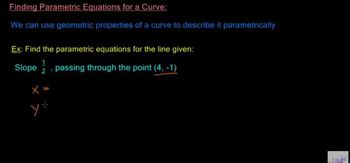Table of contents
- 0. Review of College Algebra4h 43m
- 1. Measuring Angles39m
- 2. Trigonometric Functions on Right Triangles2h 5m
- 3. Unit Circle1h 19m
- 4. Graphing Trigonometric Functions1h 19m
- 5. Inverse Trigonometric Functions and Basic Trigonometric Equations1h 41m
- 6. Trigonometric Identities and More Equations2h 34m
- 7. Non-Right Triangles1h 38m
- 8. Vectors2h 25m
- 9. Polar Equations2h 5m
- 10. Parametric Equations1h 6m
- 11. Graphing Complex Numbers1h 7m
10. Parametric Equations
Writing Parametric Equations
Problem 5.45
Textbook Question
Textbook QuestionIn Exercises 45–52, use your answers from Exercises 41–44 and the parametric equations given in Exercises 41–44 to find a set of parametric equations for the conic section or the line.
Circle: Center: (3,5); Radius: 6
 Verified Solution
Verified SolutionThis video solution was recommended by our tutors as helpful for the problem above
Video duration:
2mPlay a video:
Was this helpful?
Key Concepts
Here are the essential concepts you must grasp in order to answer the question correctly.
Parametric Equations
Parametric equations express the coordinates of points on a curve as functions of a variable, typically time (t). For a circle, these equations can be derived using trigonometric functions, where x and y coordinates are defined in terms of a parameter, allowing for a more dynamic representation of the shape.
Recommended video:

Parameterizing Equations
Circle Equation
The standard equation of a circle in a Cartesian coordinate system is (x - h)² + (y - k)² = r², where (h, k) is the center and r is the radius. This equation describes all points that are a fixed distance (the radius) from the center, providing a foundational understanding for deriving parametric equations.
Recommended video:

Equations of Circles & Ellipses
Trigonometric Functions
Trigonometric functions, such as sine and cosine, are essential for defining circular motion. In the context of a circle, the x-coordinate can be expressed as x = h + r * cos(t) and the y-coordinate as y = k + r * sin(t), where t is the parameter that varies, tracing the circle as it changes.
Recommended video:

Introduction to Trigonometric Functions

 8:02m
8:02mWatch next
Master Parameterizing Equations with a bite sized video explanation from Patrick Ford
Start learningRelated Videos
Related Practice







